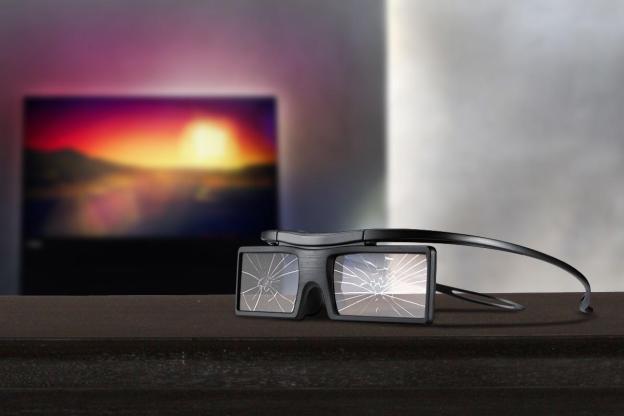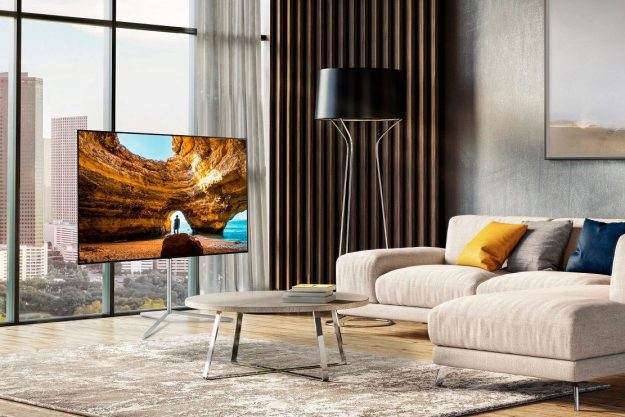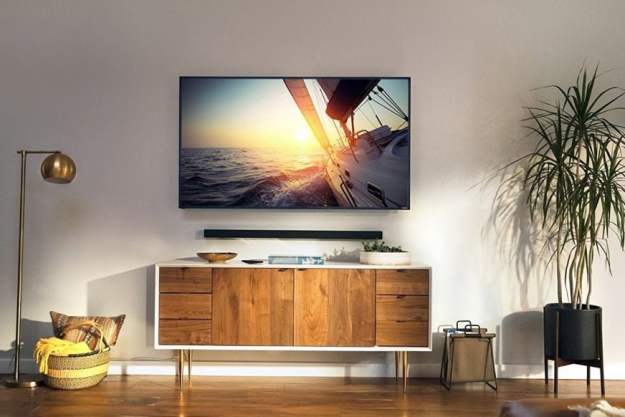
If you were shopping for a TV three years ago, you were probably bombarded with all kinds of talk about how cool 3D was and how it was the “next big thing” in TV viewing. Movies and sports would never be the same again, with characters and players popping out of screens and into your living room as if they were right in front of you. It’s now 2013, and 3D is but a footnote that barely measures up to smart TV features and the looming 4K Ultra HD resolution TVs. It all begs the question: Why didn’t 3D ever take off the way it was expected to?
There is no single answer to that question, but a variety of factors may have led to 3D’s seeming irrelevance. During CES 2010, 3D was all the rage on the show floor, and it seemed like an ideal situation for manufacturers and consumers, alike. It was relatively easy for TV makers to incorporate into flat-panel LCDs and plasmas, and it wasn’t going to cost consumers a premium to get the extra dimension onscreen. This may have looked like a perfect storm, but once you got past the action, it was all smoke and mirrors.
The introduction of 3D TVs around 2010 came smack dab in the middle of the fallout from the financial crisis, and TV sales were already flattening before the first 3D flat-panels could hit retail. With only a slight bump up in price and the promise of a flurry of 3D content, manufacturers thought this was the ticket to spurring more growth and churning dollars out of your wallet.
You couldn’t wear a pair of passive shades and watch in 3D on a TV that used active shutter technology, or vice versa.
Of course, that meant you had to wear glasses to watch in 3D, and there was a tech angle to that, too. Active shutter glasses used batteries, similar to those in watches, and had LCD lenses that alternated the frames from your left and right eye so that you perceived the image on TV in 3D. Aside from the battery life, there were other caveats to these, and chief among them were the fact they didn’t come in curved designs and had no uniformity, meaning you couldn’t use a pair of Samsung shades on a Sony TV, for example. They also didn’t come cheap, either. They were over $100-$200 a pair, depending on the brand.
Passive 3D glasses function similarly to those cheap ones you wear when watching a flick in 3D at the theater. They use polarizing lenses that present separate frames to each eye to create that 3D image. LG championed this technology early on, and some manufacturers have tried to even make “designer” passive 3D glasses that can be worn outside, complete with UV filtering and everything. They were lighter and smaller than active shutter glasses, but they couldn’t compete when it came to sharpness in picture quality. The major trade-off was that passive glasses halved the vertical resolution of the screen, so each eye was looking at a 1920 x 540 image, not a full 1080p one like active shutter provided.
The key was that 3D TVs could only support one format or the other. You couldn’t wear a pair of passive shades and watch in 3D on a TV that used active shutter technology, or vice versa. To make matters worse, TV makers were rolling out 3D (active shutter) and simultaneously promising something better (passive). Would you spend top dollar on a new 3D TV when you’re being told that something better than what you’re getting is already coming?
“The glasses are a significant factor. For example, it was one size fits all, (adults and children) and people wearing prescription glasses had to wear two pairs of glasses, plus deal with the reduced brightness level of the screen, so it didn’t take long for the novelty factor to wear off,” says Paul O’Donovan, a principal analyst at Gartner who follows the industry. “The total number of pairs of glasses that shipped with any 3D TV was always limited, which meant that sharing the content with friends and family became limited if you didn’t have enough to go around.”
So much for having a Super Bowl party in 3D. It couldn’t even work as a BYOG (bring your own glasses) affair because of the lack of cross-platform functionality. Sure, some passive shades get over that hurdle, but how many guests might have a pair of those lying around? And even if they did, what about those pesky viewing angles?
A recurring issue with 3D, which hasn’t improved a whole lot since 2010, is the reduced viewing angle. In other words, if you’re not facing the screen straight ahead, you won’t get the proper look and feel for it. That’s not necessarily a knock on the technology, it’s just the way our eyes perceive and process 3D scenes.

“Although we may be seeing a different image and perspective through each eye, we are still only focusing on a 2D surface, which is very unnatural for the human brain,” explains O’Donovan. “Our 3D vision includes re-focusing at different levels all the time because our eyes never keep still for long. Even when we look in a mirror we’re refocusing on different parts of the image, not like a TV or theater screen, where we’re only focused on the surface of the screen. The 3D image is actually looking through somebody else’s eyes — very disconcerting and our brains tire of it eventually.”
O’Donovan figures this is a big reason why even glasses-free 3D isn’t going to be a savior for 3D TV technology.
“Glasses-free solutions haven’t shown that they actually offer the same quality of experience as wearing 3D glasses, so there isn’t much hope in glasses-free in the future,” he adds. “It’s great as a novelty, but not something we want to do all the time. Our brains will just shut off as the novelty wears off.”
Then there’s the matter of content. When Avatar was raking in billions at the box office and wowing audiences with its gorgeous rendition of Pandora in eye-popping 3D, it was thought to be the beginning of a whole new era where we’d be watching our movies, shows and sports with an added dimension. Studios promised more, 3D Blu-rays were going to come out in droves and broadcasters like ESPN and Discovery Channel were going to test live 3D broadcasts.
Maybe 3D will be cooler on larger 4K Ultra HD TVs, especially with the higher resolution, but manufacturers will have to convince you that you want that extra dimension…
Except there was a trickle instead of a windfall. Avatar wasn’t a springboard, it was an anomaly. O’Donovan calculated that of the 50 3D movies released in 2011, over 30 of them were computer-generated or animated productions aimed at kids. Since kids weren’t the ones ponying up the funds for 3D home theater gear, and 3D wasn’t ideal for all kids to begin with, it’s a wonder why there was no content avalanche to follow. Even on the gaming side, most blockbuster titles didn’t even bother including 3D , so there wasn’t much momentum to build from there, either. When the new PlayStation 4 and Xbox One consoles were introduced recently, 3D wasn’t even mentioned, whereas video streaming and 4K resolutions were.
A smattering of sporting events were broadcast in 3D, but these were usually big playoff games, big races or worldwide events like the Olympics and World Cup. The BBC in the U.K. experimented with a 3D broadcast channel for two years until it announced it was axing it before the end of the year. ESPN will be silencing its own pioneering 3D channel by the end of the year. Both channels cited a lack of interest and adoption from viewers as the primary reason for cutting them off.
Despite that, not all industry players are convinced the game is over. Stream TV Networks is said to be partnering with Hisense to launch glasses-free TVs for the holiday shopping period later this year. Stream even wants to fund 3D broadcasts for some sporting events, now that Sony has backed out and is setting its sights on 4K Ultra HD. LG tried to reinvigorate it on the gaming side by showing off full-screen multiplayer gaming, where two people sitting in front of the same TV see two different images onscreen.
“Live sports events in 3D are in decline whereas 3D movie channels over cable and satellite will probably continue, as there is a relatively steady supply of 3D movie content, again mainly for kids with some more grown–up action movies,” says O’Donovan. “These will be offered at premium prices by pay-TV operators, but it won’t cost them much for the content anyway because the number of 3D subscribers is probably small, and there will be new movies released on Blu-ray in 3D. However, I think companies like Disney, which was re-working and releasing classic Disney animated movies in 3D have pulled away from that as the costs didn’t show high enough returns.”
The lack of downloadable and streaming 3D content options was another reason for its sputtering progress, O’Donovan adds. Sure, Netflix offers 3D streaming now, but it’s not for a wide range of content and there are some steps to take before you can get to it. Your Internet Service Provider (ISP) has to be connected to Netflix’s content delivery network called Netflix Open Connect. Device compatibility is also a factor, since Netflix’s Help Center lists only the PS3 and about ten LG 3D TVs as being compatible for 3D streaming.
Vudu also offers over 100 3D movies for sale or rental, but it’s a mix of animated films, documentaries, a few blockbusters and a number of mediocre titles. When it comes to TV shows, it’s a crapshoot to find any that are filmed or released in 3D. O’Donovan sees this gaping hole in available content as an issue that will be overshadowed by 4K Ultra HD anyway.
“As long as 3D movies are around in the movie theatres they will be available on Blu-ray and some pay-TV services, but they never really took off on the Internet as streamed or downloadable content, and that’s another reason for a lack of interest by the mass market,” he says. “In the meantime, we have Ultra HD coming and that’s a whole new video prospect for consumers to grapple with, but it will ultimately prove to be a significant turning point in the TV market far more than 3D could ever be.”
What’s interesting is that a majority of the processors inside most LCD and plasma TVs already have 3D functionality embedded, so most TVs are 3D-capable, if not enabled. For chipmakers, adding 3D capability to the main processors isn’t difficult or even expensive, which partly explains why many TVs today, including fairly inexpensive ones, ship with the function as part of the specification of the chip. Some TV manufacturers don’t bother with it though, and that’s why it’s not available to you, in spite of the chip’s ability to do it.
Can 3D make a ‘comeback’ almost as quickly as it became an irrelevant afterthought? Not with the way things are now. Maybe 3D will be cooler on larger 4K Ultra HD TVs, especially with the higher resolution, but manufacturers will have to convince you that you want that extra dimension, which they couldn’t do the first time around. Since they don’t control where the 3D content comes from, and Hollywood and game publishers never embraced it fast or far enough, it’s a technology that’s become a overshadowed by 4K Ultra HD, OLED and smart TV tech that looks to make more of a lasting difference. That’s the direction we’re headed in and it’s one that should make you see TV differently.
Editors' Recommendations
- Best Samsung TV deals: Save on 4K TVs, QLED TVs, OLED TVs, 8K TVs
- Best Vizio TV deals: Cheap smart TVs starting at $90
- Best OLED TV deals: Save on LG C3, Samsung S90C, and more
- This massive 77-inch LG OLED TV is $400 off at Best Buy
- Best TCL TV deals: 4K TVs as low as $150




